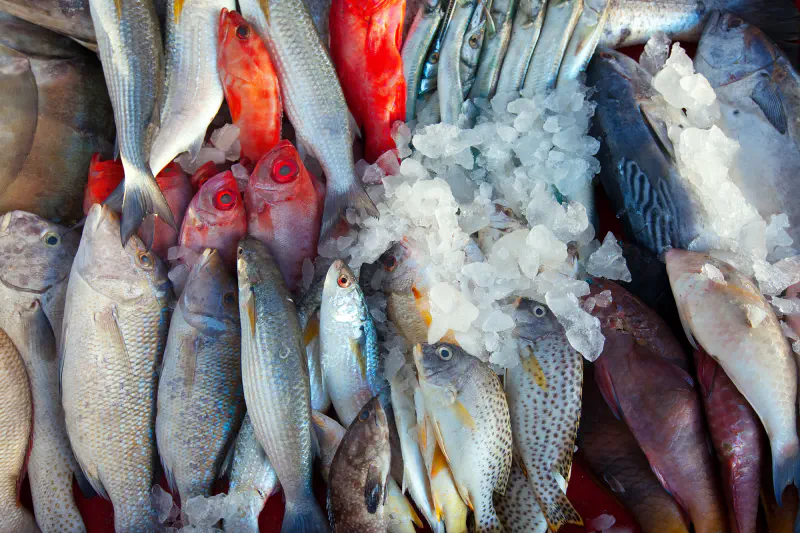In recent years, concern about heavy metal poisoning has grown, with particular focus on mercury in fish. But where does it come from, and what health risks does it pose? In this article, I answer these questions with a brief summary of mercury’s effects and how to reduce exposure.
Mercury Bioaccumulation and Biomagnification
Mercury (Hg) is a natural element found in air, water, and soil. It is released into the environment through natural phenomena like volcanic activity and rock erosion, but human activities are the main source of contamination. The most significant contributors include coal combustion (in power plants and homes), industrial processes, waste incineration, and the extraction of mercury, gold, and other metals.
Once released, mercury can be transformed into methylmercury (CH₃Hg⁺) by anaerobic bacteria in marine and freshwater sediments. This highly toxic compound accumulates in the tissues of living organisms and concentrates along the food chain through two processes.
Bioaccumulation: Methylmercury is fat-soluble and builds up in fish tissue faster than it can be eliminated, increasing its concentration over time.
Biomagnification: At each level of the food chain, predators accumulate the mercury present in their prey. This is why large predatory fish (like tuna, swordfish, and shark) have the highest concentrations.
Health Effects of Mercury
The World Health Organization considers mercury one of the ten most dangerous chemicals for public health.
The primary route of human exposure is through the consumption of fish contaminated with methylmercury. This compound is rapidly absorbed through the gastrointestinal tract and crosses key biological barriers, such as the placenta and the blood–brain barrier. Its elimination is very slow, promoting accumulation.
Once ingested, methylmercury binds to intracellular proteins and antioxidants, interfering with essential biological processes. Below are some of the main toxic effects:
Nervous system: damages neurons and myelin, leading to cognitive impairment, tremors, loss of coordination, and learning deficits in children exposed in utero.
Immune system: reduces the activity of antioxidant enzymes, promoting the accumulation of free radicals. It has also been linked to reduced activity of Natural Killer cells, which are crucial for immune defense.
Cardiovascular system: various studies have associated mercury exposure with increased risk of myocardial infarction, atherosclerosis, hypertension, and coronary dysfunction.
Minamata Case, Japan
In 1956, Minamata Bay in Japan was contaminated with methylmercury discharged by a chemical plant. A similar event occurred in 1965 in Niigata Prefecture, and in both cases, thousands of people were poisoned after consuming contaminated fish.
Minamata disease caused severe neurological symptoms, including paralysis, tunnel vision, hearing disorders, tremors, and permanent nervous system damage. Particularly alarming were cases of pregnant women who, despite having mild or no symptoms, gave birth to children with serious neurological disorders.
Many patients presented with extensive brain lesions, and in addition to acute cases, numerous chronic poisonings were recorded, with symptoms emerging gradually.
The ongoing release of mercury into the environment and the demonstrated harm to human health led to the adoption of the Minamata Convention on Mercury in 2013. This treaty obliges signatory governments to control air emissions and gradually phase out certain mercury-containing products.
Safety Limits
Most countries and international organizations set a maximum mercury limit in fish around 0.5 mg/kg. Specifically, Regulation (EU) 2022/617 established a limit of 0.5 mg/kg for most fish species, and 1 mg/kg for predatory species like shark, swordfish, and tuna.
EFSA Statement on the Benefits of Fish vs. Methylmercury Risks
EFSA, the European Food Safety Authority, analyzed the risks and benefits of fish consumption, estimating how many portions are needed to achieve adequate omega-3 intake without exceeding safe mercury levels.
It highlighted that consuming species with high methylmercury content can quickly exceed safety thresholds (<1–2 servings per week), without ensuring sufficient omega-3 intake.
For this reason, EFSA recommends 1–4 weekly servings of small, low-mercury species.
Omega-3 in Plant-Based Sources
Those who do not eat fish, such as vegans and vegetarians, can obtain omega-3 directly from plant sources.
Even among omnivores, omega-3 intake is often insufficient: recommended amounts of fish may not meet requirements, and cooking or freezing can further reduce content. For this reason, it’s useful to also include plant sources.
According to VegPlate, to meet the estimated omega-3 requirement regardless of calorie intake, it is enough to consume two daily servings of foods rich in alpha-linolenic acid (ALA), a short-chain omega-3.
One serving corresponds to:
- Flaxseed oil (stored in the fridge, after cold chain) – 5 g (1/2 tablespoon).
- Flaxseeds, ground before consumption – 10 g (1 tablespoon).
- Chia seeds, ground – 15 g (1.5 tablespoons).
- Walnuts – 30 g (3 tablespoons).
Later, our body can convert ALA into EPA and DHA, long-chain omega-3 fatty acids. However, this conversion is limited and influenced by the amount of omega-6 present in the diet. It appears to be more efficient when the omega-6/omega-3 ratio approaches 1:1. In any case, a ratio below 4:1 is generally considered optimal.
The main omega-6 fats are linoleic acid and arachidonic acid.
Among the foods richest in linoleic acid are most vegetable oils (excluding flaxseed, hemp, and olive oils), mayonnaise, margarine, and lard.
Among those rich in arachidonic acid: lard, chicken, turkey, eggs, and pork.
Vegetarian and vegan women, or those who do not consume enough fish during pregnancy and breastfeeding, are advised to take a daily DHA supplement derived from microalgae to meet increased needs.
